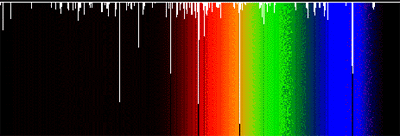interstellar extinction

Spectrum showing around 100 diffuse interstellar bands.
Interstellar extinction is the dimming of light from stars and other distant objects, especially pronounced in the galactic plane, due the combined effects of interstellar absorption and scattering of light by dust particles. Interstellar extinction increases at shorter (bluer) wavelengths, resulting in interstellar reddening. It is least in the radio and infrared region, which makes these wavelengths suitable for seeing across large distances in the galactic plane and, in particular, for probing the nucleus of the Milky Way.
Interstellar absorption
Interstellar absorption is the absorption of light from stars and other background objects by gas and dust in interstellar space; it is greatest along the galactic plane where most of the gas and dust lies. As well as continuous absorption, there are diffuse interstellar bands and atomic absorption lines, such as the H and K lines of calcium and the D lines of sodium. Interstellar absorption is a component of interstellar extinction, which also includes the effects of scattering from dust.
Diffuse interstellar bands
Diffuse interstellar bands are a series of absorption bands, of interstellar origin, first recorded on photographic plates of the spectra of distant stars in the early 1900s. Well over 100 such bands have been identified in the ultraviolet, visible, and near infrared regions of the spectrum, between wavelengths of 440 to 685 nanometers. According to some estimates, up to 10% of cosmic carbon may be in the molecules that cause these features.
Identifying the carriers of diffuse interstellar bands has become one of the classic astrophysical spectroscopic problems. Recent work suggests they are caused by polycyclic aromatic hydrocarbons (PAHs), or, most likely, their cations, since PAH ions of all sizes absorb in the visible and near infrared, and such molecules are expected to be ionized by the intense ultraviolet field present in much of the interstellar medium.
Reference
1. Herbig, G. H. "The Diffuse Interstellar Bands," Annual Review of Astronomy and Astrophysics, 33, 359 (1995).


